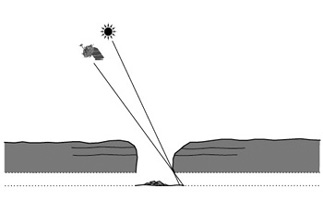The LROC NAC acquired an oblique view of the Marius Hills pit with just the right angle to reveal an overhang. Pit is about 65 meters in diameter, M137929856R.
 |
| Click on image for larger version |
Cartoon of the imaging geometry in cross section,
which allows a view of the lava tube floor |
In this geometry, the NAC was able to image a few meters under the overhang discovering a sublunarean void! Will astronauts someday explore under the mare? What scientific riches wait to be discovered within the unseen reaches of sublunarean voids?
Also note how the oblique angle really brings out the layered nature of the mare bedrock in the pit walls. These exposed layers give scientists important clues as to how the vast mare were deposited.
NASA's Goddard Space Flight Center built and manages the mission for the Exploration Systems Mission Directorate at NASA Headquarters in Washington. The Lunar Reconnaissance Orbiter Camera was designed to acquire data for landing site certification and to conduct polar illumination studies and global mapping. Operated by Arizona State University, LROC consists of a pair of narrow-angle cameras (NAC) and a single wide-angle camera (WAC). The mission is expected to return over 70 terabytes of image data.

